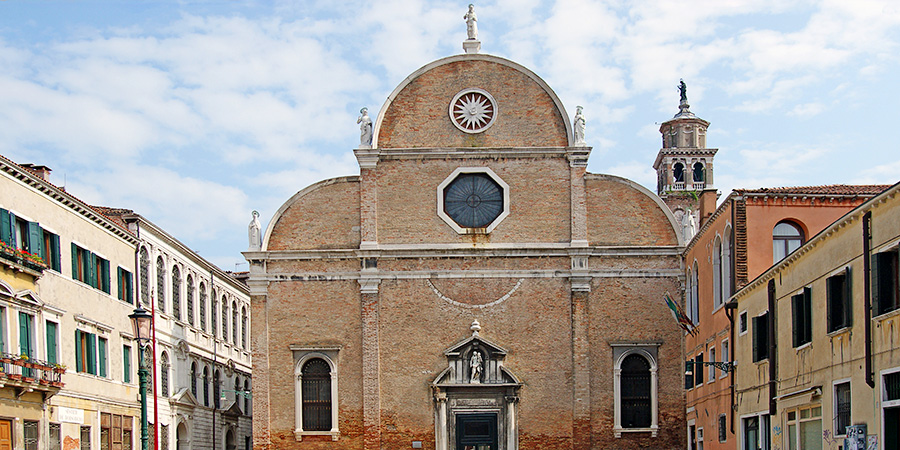The Church of Santa Maria dei Carmini (Saint Mary of Carmel) or simply I Carmine, as it is popularly known, is somewhat hidden from the Campo de Santa Margherita.
The construction of the church of the former Carmelite convent began in 1286, from which it can be deduced that the Carmelites settled in the town on the lagoon shortly after the reform of the order in the 13th century, following which new rules were instituted and the Carmelites abandoned hermitism, the vow of silence and the prohibition of eating meat and became a mendicant order dedicated to caring for the souls of the Venetians.
Facade of Santa Maria dei Carmini
The main façade of the church adjacent to the Campo dei Carmini convent was the subject of a thorough remodelling in the 16th century. Above the entrance door, an ancient circular rose window can still be seen, which is now bricked up. The façade is made of typical Venetian bricks, which although simple, give it great effectiveness. The entrance is through the old side door that opens onto Campo Santa Margherita.
Interior of Santa Maria dei Carmini
The basic structure of the Gothic work is easily identifiable. The naves are separated from each other by columns. The choir acquired its present appearance after a remodelling carried out in 1514. The architect Sebastiano da Lugano curiously combined the Gothic components of the choir with Renaissance elements. He divides the narrow arcades into three window zones, of which those in the upper row are semicircular arches. The gilded and painted carvings in the central nave are from the late 16th and early 17th centuries.
The most outstanding works of art in Santa Maria del Carmelo are:
- The counter-façade contains the funerary monument of Jacopo Foscarini, Procurator of St Mark and Admiral of the Venetian fleet, by Francesco Contin. The family of Jacopo Foscarini lived in the palace opposite the church façade, on the other side of the river.
- On the second altar is the Nativity with Saints (1509-1511) by Cima da Conegliano.
- On the third altar on the right is the Madonna del Carmelo with Saints (c. 1597 - 1604) by Pace Pace. The statues of the Virginity (left) and Humility (right) were made by Antonio Corradini and Giuseppe Torretto respectively. The frontal wooden representation of the Miracle of the Virgin (1724) was carved by Francesco Bernadoni.
- On the ceiling, a fresco with the Glorification of the Scapular (1709) by Sebastiano Ricci. In the fresco, the angel holds the scapular and the painted inscription indicates that it is an ornament from Mount Carmel.
- Between the entrance and the sacristy there is an altar, which was made by associating the Fish Merchants (1548) with an altarpiece of the Presentation of Jesus in the Temple (1541-1542) by Jacopo Tintoretto, placed on the altar of the Purification of Mary.
- In the third chapel on the left is the Lamentation of the Death of Christ (ca. 1476) by the painter Francesco di Giorgio Martini.
- The first altar is decorated with the painting Saint Nicholas in Glory by Lorenzo Lotto.
- The second altar features two statues of Elijah and Elisha, made by Tommaso Ruer, in which the Elijah holds a flaming sword in his hand.
- In front of the presbytery there are some paintings by Marco Vicentino, Palma il Giovane and Gaspare Diziani.
Location of the Santa Maria dei Carmini
- Address: Sestiere Dorsoduro, 2612 - 30123 Venezia, Italia.
- Sestiere: Dorsoduro


